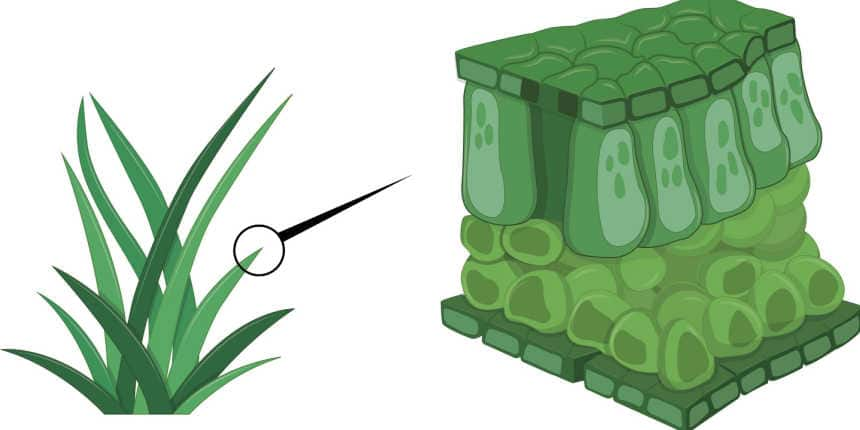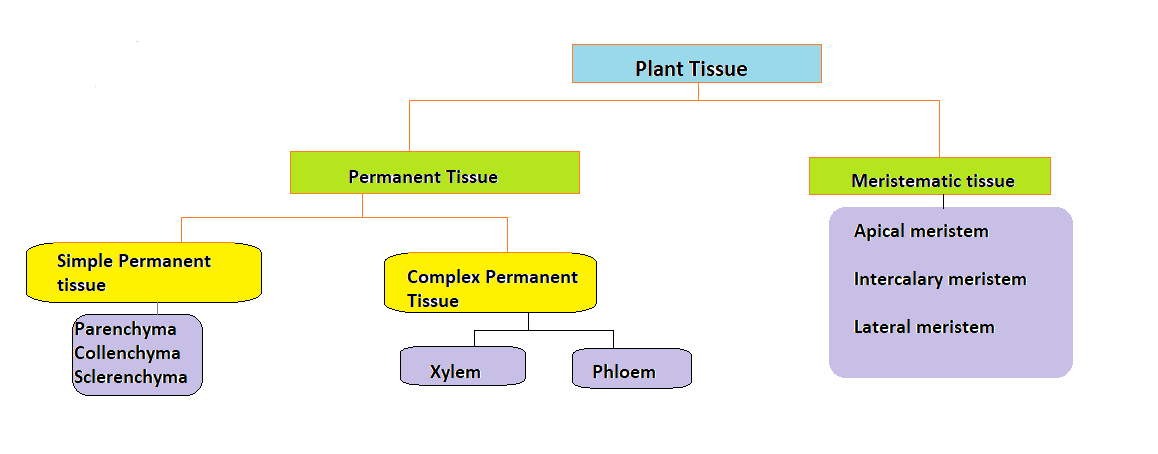How Many Types of Plant Tissues are There?
There are two types of plant tissue.

The biological level of organisation between a cell and an entire organ is called a "tissue." A tissue is made up of a group of comparable cells from the same origin that work together to perform a single function. Moreover, the extracellular matrix is present in these cells. The functional grouping of numerous tissues results in the formation of organs. Plants have evolved tissues made of dead cells that provide structural support as a result of their immobility. They must endure extreme weather, including high winds, storms, floods, and other natural disasters.
Two general types of plant tissue are distinguished:
Meristematic tissue
Permanent (or non-meristematic) tissue
Based on the cell structure, proposed function, and location within the tissue, these tissue groups are further subdivided into smaller groups.

Animal stem cells and meristematic tissue are similar in that they both contain undifferentiated cells that proliferate and support plant growth. Permanent tissue is made up of plant cells that are no longer actively dividing.
Cells that quickly differentiate or specialise into permanent tissue are produced by meristems. Once these cells develop a certain set of functions, they stop proliferating. They divide into three distinct tissue types:
Dermal tissue is made up of the cells that line the outside of leaves and the young plant body.
The xylem and phloem, which are the primary constituents of vascular tissue, transport nutrients and fluids internally.
Though less differentiated than other tissues, ground tissue still uses photosynthesis to produce and store nutrients.
Stems and leaves comprise the shoot system. Each of the three types of tissues (ground, vascular, and dermal) can be found in the roots, stems, and leaves of an organ. Each type of tissue is made up of different cell types, and the structure of each cell type affects how that tissue functions.
Plant Tissue
1. Meristematic Tissue
Cells in meristematic tissue are actively dividing, which causes the plant to get longer and thicker. Only particular regions of a plant, like the tips of stems or roots, go through primary growth. These regions contain meristematic tissue.
These cells can have thin cell walls and a variety of shapes, including round, polyhedral, and rectangular ones. The meristem initially generates meristem-specific new cells, but as they mature and expand, their characteristics gradually shift, and they separate into meristematic tissue components, which are classified as:
Apical meristem: The lengthening apical meristems, which are found at the growing tips of stems and roots, are present. The lengthening, also known as primary growth, is brought on by the creation of growing parts at the tips of roots and stems. This meristem manages the linear development of an organ.
Lateral meristem: Cells that primarily divide in one plane, or the lateral meristem, increase the organ's diameter and girth. The cork cambium and vascular cambium that make up the lateral meristem are typically found in dicotyledon vascular bundles and beneath the tree's bark. Secondary growth is created by this cambium's activity.
Intercalary meristem: The intercalary meristem is typically found at the base of the node, internode, and leaf base. It is situated in the space between permanent tissues. They are in charge of the internode's expansion and the lengthening of the plant. They promote branch growth and development.
Meristematic tissue cells have a cellulose-based primary cell wall that is both thin and elastic. Without intercellular spaces, they are arranged closely together. Every cell has a sizable nucleus and a substantial amount of cytoplasm. In the dense protoplasm of meristematic cells, there are hardly any vacuoles. Typically, the meristematic cells have a rectangular, polygonal, or oval shape.
Meristematic tissue cells have a large nucleus and no need for intercellular spaces because their purpose is to multiply and increase the girth and length of the plant, not to store anything. They also have small or no vacuoles.
2. Permanent tissues
Permanent tissues are made up of living or dead cells and are assembled from meristematic tissues that have stopped being able to divide and have been fixedly positioned inside the plant's body. Meristematic tissues that adopt a particular function lose their capacity to proliferate.
Permanent tissues come in two different categories:
simple permanent tissues
complex permanent tissues
A. Simple permanent tissue
Simple permanent tissue is made up of an aggregate of cells that have a common origin, structure, and function. They come in three categories:
Parenchyma
Collenchyma
Sclerenchyma
B. Complex permanent tissue
The intricate permanent tissue is composed of various cell types that all descend from a single common ancestor and work together as a single unit. The movement of water, organic solutes (food substances), and mineral nutrients is complex tissues' primary function. Because of this, it is also known as "conducting" and "vascular" tissue.
The following are typical examples of complex permanent tissue:
Xylem (or wood)
Phloem (or bast).
Xylem and phloem together form vascular bundles. Sometimes a layer of dead tissue is present between them; this layer is called the cambium.
Examples
Parenchyma
The majority of the body is made up of parenchyma. There are intercellular spaces between the cells of this tissue because it is composed of relatively unspecialized living cells from plants, which are typically loosely packed and have thin cell walls. The shape of them is usually isodiametric. They occasionally have no vacuoles, occasionally have a few, or occasionally have a few and none at all. However, even if they do, the vacuole is still much smaller than those found in typical animal cells. In addition to supporting plants, this tissue also stores food.
Chlorenchyma, which performs photosynthesis and contains chlorophyll, is a special kind of parenchyma.
Aquatic plants have large air cavities in their aerenchyma tissues, which give them the buoyancy they need to float on the water. The parenchymal cells, called idioblasts, contain metabolic waste.
Water is stored in the parenchymal tissues of xerophytes.
Chlorenchyma, which performs photosynthesis and contains chlorophyll, is a special kind of parenchyma.
Aquatic plants have large air cavities in their aerenchyma tissues, which give them the buoyancy they need to float on the water. The parenchymal cells called idioblasts contain metabolic waste.
Water is stored in the parenchymal tissues of xerophytes.
Collenchyma
Similar to parenchyma, collenchyma is the body's main living tissue. The words colla, which means gum, and enchyma, which means infusion, are the origins of the word's name in Greek.
These cells have thin walls, but at their intersections, cellulose, water, and pectin substance thickenings (pectocellulose) are present. The plant's tensile strength is due to its tightly packed tissue cells and condensed intercellular spaces. Most often, it can be seen in the hypodermis of stems and leaves. Monocot plants and roots don't have it.
Young plants' stems have collagenous tissue that serves as supporting tissue. It mechanically supports the plant body while also making it elastic and tensile. Making and storing sugar as starch is simpler. It is located there and protects leaves from the tearing action of the wind.
Sclerenchyma
Thick-walled, dead cells with little protoplasm make up the majority of sclerenchyma. Scleros in Greek means hard, and enchyma is an infusion.
These cells have hard, incredibly thick secondary walls as a result of their regular distribution, high levels of lignin secretion, and they function as a source of mechanical support. They don't overlap in any intermolecular space. Strong, rigid, and water-impervious cell walls develop in sclereids, or stone cells, as a result of excessive lignin deposition.
Epidermis
The plant's entire surface is covered by the epidermis, also known as surface tissue, which is made up of just one layer of cells. The entire surface of the plant is covered by this outer layer of epidermis. The term "surface tissue" has thus come to refer to it. Epidermal cells are primarily fairly flat in shape. Frequently, the lateral and outer walls of the cell are thicker than the inner walls. A continuous sheet is produced because there are no gaps between the cells. It safeguards the entire plant.
Xylem
The name "xylem," which derives from the Greek word for wood, "xylos," refers to the primary conducting tissue in vascular plants. Inorganic and water solutes are conducted through it.
The four cell types that make up xylem are:
Tracheids
vessels (or tracheae)
Xylem sclerenchyma or Xylem fibres
Xylem parenchyma
Xylem tissue is arranged in a tube-like pattern along the major axes of stems and roots. Tracheids, ray cells, fibres, vessels, and parenchymal cells are the components of this tissue. Longer tubes are made up of tracheids and distinct cells, which are referred to as "vessels" and have open ends. Internally, there might be wall-material bars that cross the open space. These cells are connected end to end to form long tubes. At maturity, both tracheid and vessel components are dead. The secondary cell walls of tracheids are thick and tapered at the ends. They lack the end openings that vessels have. On each end, there are two pits that overlap one another. Water can move between cells thanks to the pit pairs.
Phloem
Phloem consists of:
Sieve tube
Companion Cell
Phloem fibre
Phloem parenchyma.
Throughout the plant, dissolved food components are primarily transported by phloem. This conduction system's companion cells and sieve-tube components lack secondary walls. The parent cells of the vascular cambium produce both xylem and phloem. Additionally, this frequently includes fibres, parenchyma, and ray cells. Sieve tubes are made by laying the end members of sieve tubes together. Unlike vessel members in the xylem, the end walls do not have openings. However, the cytoplasm that connects cells extends through minuscule pores found all along the end walls. These pore-filled connections are known as "sieve plates." They lose their nuclei as sieve-tube members get older, but their cytoplasm still contributes significantly to food substance conduction. Food conduction is produced by companion cells, which are tucked inside the sieve-tube members. Phloem helps plants move materials up and down as needed, including nutrients.
Applications for Admissions are open.
As per latest syllabus. Physics formulas, equations, & laws of class 11 & 12th chapters
JEE Main Important Chemistry formulas
Get nowAs per latest syllabus. Chemistry formulas, equations, & laws of class 11 & 12th chapters
JEE Main high scoring chapters and topics
Get nowAs per latest 2024 syllabus. Study 40% syllabus and score upto 100% marks in JEE
JEE Main Important Mathematics Formulas
Get nowAs per latest syllabus. Maths formulas, equations, & theorems of class 11 & 12th chapters